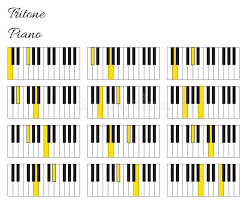How to use tritones in music Lesson 1
A tritone is the division of an octave into 2 equal parts, and is measured as an interval between a note and its diminished 5th i.e. 1-b5. This interval is one of the most dissonant sounds, alongside a minor 2nd interval.
There are twelve notes in an octave and dividing it into half gives 6 notes, each pairing up with their individual b5 to give us 6 unique pairs of tritones viz:
CGb, C#G, DAb, EbA, EBb and FB.
How are tritones used in music?
I know of 2 ways.
One is in a chord substitution known as a tritone sub, where one dominant chord is used in place of another doninant chord, both being a tritone away e.g. using Db7b5 to sub G7b5 because G and Db are a tritone interval away. The reason this works very well is because both chords share the same shell [3 and b7 notes] which themselves are also a tritone pair. In some cases, they share the same notes e.g. G7b5 is GBDbF and Db7b5 is DbFGB, both sharing all their notes and are called enharmonic equivalent chords.
The second way tritones are used is in voicing of chords, especially dominant chords. This is what folks popularly call tritones. There are several ways to play this but I'll hit on the easiest one - a major triad over a tritone pair. BTW, when a chord is voiced such that the lowest notes are a tritone pair, it is said to be voiced as a tritone. So we'll consider the format of major triad over a tritone pair e.g. AC#E/FB which is C#7#5#9 or a G13#11 if played over a G bass.
How are these tritone voiced chords formed and used?
Easy. Get a tritone pair and play the major triad of a whole step below any of the pair, e.g. Ab and D make a tritone pair. A whole step below Ab gives Gb and a whole step below D gives C, so our major triads are Gbmaj and Cmaj. Putting it all together, our tritone voiced chord would be GCE/DAb or BbDbGb/DAb.
Using them takes 2 directions:
A. In context of a base note e.g. in a 5-1 in key Fmaj, we can voice the 5 as a tritone using the root or the shell as our base note [not bass note] viz: BbDF/CGb or AbBE/CGb OR DF#A/EBb or CEbAb/EBb. Any of this 4 tritones can be used on the 5 to approach the Fmaj7 [1 chord].
B. In context of a top note e.g. in key Ebmaj, using the melody in the song 'Lord you are more precious than Silver… ' , the words 'there's nothing' would have the melody as Bb, Ab. The word 'nothing' on a 4 chord would be AbCEbAb/CG for Abmaj7. The word 'there's' is where we intend to use a tritone voicing with the melody on top. So we find major triads that have Bb. They are Bbmaj [DFBb], Gbmaj [DbGbBb] and Ebmaj [EbGBb]. The next step is to build a tritone pair on a whole step above these triads: for Bbmaj, we'll have DFBb/CGb [we saw this in point A above], for Gbmaj, we'll have DbGbBb/AbD [we saw this too above] and for Ebmaj, we'll have EbGBb/FB.
Any of these 3 chords will give you a lush sound.
Try them:
DFBb/CGb ~ AbCEbAb/CG
DbGbBb/AbD ~ CEbAb/C
EbGBb/BF ~ AbCEbAb/CG

#pianolessons #chords #scales #piano #chordprogression #inversions #tutorial #music #tritones #jazz #lesson #movement